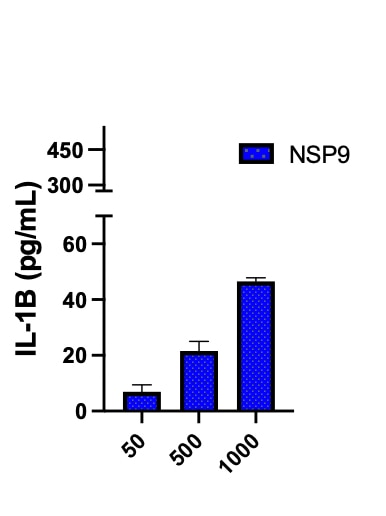Recombinant SARS-CoV-2 NSP9 His-tag Protein, CF Summary
Product Specifications
Asn1-Gln113
with N-terminal Met and C-terminal 6-His tag
Analysis
Product Datasheets
Carrier Free
CF stands for Carrier Free (CF). We typically add Bovine Serum Albumin (BSA) as a carrier protein to our recombinant proteins. Adding a carrier protein enhances protein stability, increases shelf-life, and allows the recombinant protein to be stored at a more dilute concentration. The carrier free version does not contain BSA.
In general, we advise purchasing the recombinant protein with BSA for use in cell or tissue culture, or as an ELISA standard. In contrast, the carrier free protein is recommended for applications, in which the presence of BSA could interfere.
10631-CV
| Formulation | Supplied as a 0.2 μm filtered solution in HEPES and NaCl. |
| Shipping | The product is shipped with dry ice or equivalent. Upon receipt, store it immediately at the temperature recommended below. |
| Stability & Storage: | Use a manual defrost freezer and avoid repeated freeze-thaw cycles.
|
Scientific Data
 View Larger
View Larger
2 μg/lane of Recombinant SARS-CoV-2 NSP9 His-tag (Catalog # 10631-CV) was resolved with SDS-PAGE under reducing (R) and non-reducing (NR) conditions and visualized by Coomassie® Blue staining, showing a band at 13 kDa under reducing conditions.
Reconstitution Calculator
Background: NSP9
Non-structural protein 9 (NSP9) is one of several functional proteins released by ORF1a-encoded protease cleavage of the pp1a and pp1ab replicase polyproteins expressed from the coronavirus (CoV) genome (1). The NSPs are involved in the replication and transcription of the viral RNA and not incorporated within the virion particles. Coronaviruses include various highly pathogenic strains such as SARS-CoV, MERS-CoV and SARS-CoV2 that have had significant impact on humans as well as strains that have negatively impacted livestock. NSP9 is a small 113 amino acid protein that forms a biologically active homodimer where each monomer consists of a beta barrel and C-terminal helical domain motif that promotes obligate dimerization (2,3). NSP9 is capable of binding nucleic acids in a nonsequence-specific manner with a preference of a single stranded RNA (4,5) although disruption of the dimeric interface appears to impact RNA binding (6). The NSP9 sequence is conserved across coronaviruses (3). NSP9 was shown to interact with other viral NSP proteins including NSP7, NSP8, and NSP12 (5,7,8). In addition, NSP9 has been shown to bind host cell proteins including DEAD-box RNA helicase 5 (DDX5), the ubiquitin E3 ubiquitin ligase MIB1, and elongation factor eIF4H in SARS-CoV2 and related viruses (9,10). The interactions of NSP9 with these host cell proteins promote viral replication (9,10) supporting the conclusion that NSP9 is important for virulence (2,3).
- Snijder, E.J. et al. (2016) Adv. Virus Res. 96:59.
- Miknis, Z.J. et al. (2009) J. Virol. 83:3007.
- Littler, D.R. et al. (2020) iScience 23:101258
- Egloff, M.P. et al. (2004) Proc. Nat. Acad. Sci. U.S.A. 101:3792.
- Sutton, G. et. al. (2004) Structure 12:341.
- Hu, T. et al. (2017) Protein Sci. 26:1037.
- von Brunn, A. et al. (2007) PLoS One 2:e459.
- Chen, J. et al. (2017) Front. Microbiol. 8:853.
- Zhao, S. et al. (2015) Virus Res. 195:217.
- Gordon, D.E. et al. (2020) Nature 583:459.
FAQs
No product specific FAQs exist for this product, however you may
View all Proteins and Enzyme FAQsReviews for Recombinant SARS-CoV-2 NSP9 His-tag Protein, CF
Average Rating: 5 (Based on 1 Review)
Have you used Recombinant SARS-CoV-2 NSP9 His-tag Protein, CF?
Submit a review and receive an Amazon gift card.
$25/€18/£15/$25CAN/¥75 Yuan/¥2500 Yen for a review with an image
$10/€7/£6/$10 CAD/¥70 Yuan/¥1110 Yen for a review without an image
Filter by:

